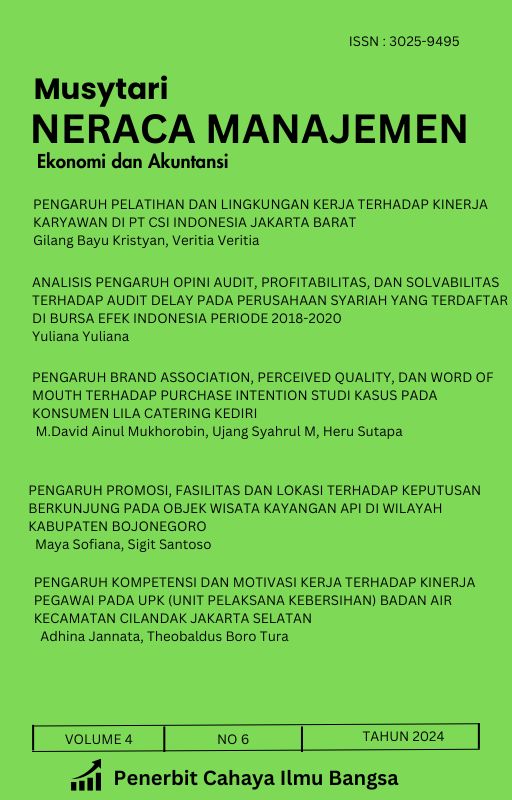ANALISIS NIAT PENGGUNAAN TAPCASH E-MONEY MAHASISWA BISNIS DIGITAL UNJ
Main Article Content
Abstract
Penelitian ini bertujuan untuk menganalisis niat penggunaan TapCash e-money di kalangan mahasiswa Bisnis Digital Universitas Negeri Jakarta. Dengan menggunakan Model Penerimaan Teknologi (TAM), penelitian ini mengeksplorasi pengaruh persepsi manfaat, kemudahan penggunaan, dan pengetahuan terhadap sikap dan niat pengguna. Data dikumpulkan melalui kuesioner yang disebarkan kepada 100 responden menggunakan metode random sampling. Hasil penelitian menunjukkan bahwa persepsi manfaat memiliki pengaruh positif signifikan terhadap sikap, sedangkan sikap terhadap penggunaan berperan sebagai mediator utama dalam membentuk niat penggunaan. Selain itu, pengetahuan tentang TapCash juga berkontribusi positif terhadap niat melalui sikap pengguna. Implikasi penelitian ini menunjukkan pentingnya edukasi dan peningkatan fitur untuk meningkatkan adopsi TapCash.
This study aims to analyze the intention to use TapCash e-money among Digital Business students at Universitas Negeri Jakarta. Utilizing the Technology Acceptance Model (TAM), this research examines the influence of perceived usefulness, ease of use, and knowledge on user attitudes and intentions. Data were collected through questionnaires distributed to 100 respondents using random sampling methods. The findings reveal that perceived usefulness significantly impacts attitudes, while attitudes serve as a primary mediator in shaping usage intentions. Additionally, knowledge about TapCash positively contributes to intentions through user attitudes. The study implies the importance of education and feature enhancements to improve TapCash adoption.
Downloads
Article Details

This work is licensed under a Creative Commons Attribution-NonCommercial 4.0 International License.
This work is licensed under a Creative Commons Attribution-ShareAlike 4.0 International License.
References
Buku:
P. Alma, Manajemen Pemasaran & Pemasaran Jasa. Bandung: Alfabet, 2018.
Jogiyanto, Sistem Informasi Keperilakuan. Yogyakarta: Andi, 2007.
P. Kotler dan K. L. Keller, Marketing Management, 15th ed. Pearson Education, 2016.
Artikel Jurnal:
I. Adamson and J. Shine, “Extending the new technology acceptance model to measure the end user information systems satisfaction in a mandatory environment: A bank’s treasury,” Tech. Anal. & Strategic Manage., vol. 15, no. 4, pp. 441–455, 2003. DOI: 10.1080/09537320300013653.
F. D. Davis, “Perceived usefulness, perceived ease of use, and user acceptance of information technology,” MIS Q., vol. 13, no. 3, pp. 319–340, 1989.
W. Lewis, R. Agarwal, and V. Sambamurthy, “Sources of influence on beliefs about information technology use: An empirical study of knowledge workers,” MIS Q., vol. 27, no. 4, pp. 657–678, 2003.
J. Lu, C.-S. Yu, C. Liu, and J. E. Yao, “Technology acceptance model for wireless Internet,” Internet Research, vol. 13, no. 3, pp. 206–222, 2003. DOI: 10.1108/10662240310478222.
D. Kreltszheim, “Identifying the proceeds of electronic money fraud,” Inf. Manage. & Comp. Security, vol. 7, no. 5, pp. 223–231, 1999. DOI: 10.1108/09685229910375419.
V. Venkatesh, M. G. Morris, G. B. Davis, and F. D. Davis, “User acceptance of information technology: Toward a unified view,” MIS Q., vol. 27, no. 3, pp. 425–478, 2003. DOI: 10.2307/30036540.
Artikel Prosiding:
D. Rahmatsyah, “Faktor-faktor yang mempengaruhi minat penggunaan produk baru (Studi kasus: Uang elektronik kartu Flazz BCA),” in Seminar Nasional Teknologi Finansial dan Digitalisasi Bisnis, Jakarta, 2011.
Artikel Online:
Bain & Company, “e-Conomy SEA 2022 report: Southeast Asia’s digital economy is on course towards $200B GMV in 2022, three years earlier than projected,” Bain & Company, Oct. 27, 2022. [Online]. Tersedia: https://www.bain.com [Diakses: 7 Des. 2024].
Bank Negara Indonesia (BNI), “TapCash,” BNI Official Website. [Online]. Tersedia: https://www.bni.co.id [Diakses: 7 Des. 2024].
Tesis:
D. Rahmatsyah, “Faktor-faktor yang mempengaruhi minat penggunaan produk baru (Studi kasus: Uang elektronik kartu Flazz BCA),” Master Thesis, Univ. Indonesia, Jakarta, Indonesia, 2011.
Tambahan Referensi 10 Tahun Terakhir:
X. Zhang and T. Rai, “Digital payment systems adoption and its impact on user behaviors,” Journal of Business Research, vol. 123, pp. 23–31, 2021. DOI: 10.1016/j.jbusres.2020.12.031.
R. S. Kumar and A. Sharma, “Exploring user adoption of mobile payment systems: An empirical study in emerging markets,” Asian Journal of Business and Accounting, vol. 14, no. 2,pp. 55–80, 2021. DOI: 10.22452/ajba.vol14no2.4.
Y. Wang, W. Wang, and Y. Zhang, “Exploring the factors influencing the adoption of mobile payment in rural areas: An integration of TAM and TPB,” Journal of Retailing and Consumer Services, vol. 65, p. 102736, 2022. DOI: 10.1016/j.jretconser.2021.102736.
H. M. Nguyen and T. P. Vu, “Factors influencing consumers’ behavioral intention toward e wallet adoption in Vietnam: An integrated model,” Technological Forecasting and Social Change, vol. 175, p. 121433, 2022. DOI: 10.1016/j.techfore.2021.121433.
P. Liao, S. P. Chuang, and H. Fang, “Impact of trust on mobile payment adoption: An empirical study based on the TAM model,” Journal of Theoretical and Applied Electronic Commerce Research, vol. 16, no. 4, pp. 792–806, 2021. DOI: 10.3390/jtaer16040045.
K. K. Sharma and P. Balaji, “Understanding customer trust in mobile payment apps: The mediating role of perceived ease of use and perceived usefulness,” Electronic Commerce Research, vol. 22, pp. 467–491, 2022. DOI: 10.1007/s10660-021-09484-4.
T. Thakur and A. Sharma, “Evaluating the role of perceived risk and trust in mobile wallet adoption: A moderated mediation study,” Journal of Retailing and Consumer Services, vol. 64, p. 102786, 2021. DOI: 10.1016/j.jretconser.2021.102786.
J. A. Lin and C. F. Chuang, “Perceived security and trust in FinTech services: An extension of the TAM model,” Asia Pacific Journal of Innovation and Entrepreneurship, vol. 14, no. 3, pp. 235–251, 2020. DOI: 10.1108/APJIE-06-2020-0037.
K. L. Ahmad, “Adoption of digital payment systems in the post-pandemic era: Insights from Indonesia,” in Proceedings of the 12th International Conference on Digital Transformation and Business Innovation (ICDTBI), Jakarta, pp. 78–84, Sept. 2022.

